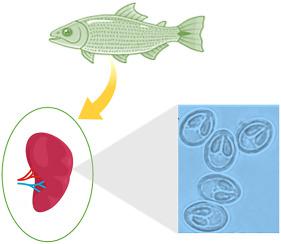Microbial Pathogenesis ( IF 3.3 ) Pub Date : 2020-12-29 , DOI: 10.1016/j.micpath.2020.104718 Tiago Milanin 1 , Patrick D Mathews 2 , André C Morandini 3 , Omar Mertins 4 , Fabienne Audebert 5 , Jose O L Pereira 1 , Antonio A M Maia 1

|
A new cnidarian myxosporean infecting the spleen of an economic and ecological important bryconid fish (Salminus franciscanus) is described based on integrative taxonomic approach including morphological, ultrastructural, biological traits, geography, molecular data and phylogenetic analysis. In a total of thirty specimens examined, nineteen (63.3%) were infected by an undescribed parasite species belonging to the genus Myxobolus. Plasmodial development was asynchronous, with young development in the periphery and mature myxospores in the central area and without projections and microvilli in the plasmodial wall. Mature myxospores were ovoid in shape and measured 7.9 ± 0.2 μm (7.6–8.1 μm) in length and 5.4 ± 0.1 μm (5.0–5.6 μm) in width. The two polar capsules were equal in size, occupying a little more than half of the myxospore body, measuring 4.0 ± 0.2 μm (3.9–4.1 μm) in length and 1.7 ± 0.1 μm (1.5–1.8 μm) in width. The polar tubules coiled in six turns, perpendicular to the long axis of polar capsule. Phylogenetic analysis placed the new species within a clade containing nine myxobolid species from South American characiforms fish and appears as a close species of Myxobolus pantanalis. Nevertheless, the sequences of the new species and M. pantanalis have a large genetic divergence of 13.5% in their SSU rDNA. In light of the differences observed from the integrative taxonomy, we confidently considered that this isolate is a new species of cnidarian myxosporean, M. douradae n. sp., increasing the knowledge of diversity of this enigmatic group of cnidarians.
中文翻译:

一种新的侵染巴西经济和生态上重要的蓝藻类鱼类的刺胞新孢子虫的脾脏的形态结构数据和系统发育关系
基于包括形态,超微结构,生物学特性,地理,分子数据和系统发育分析在内的综合分类学方法,描述了一种新的刺胞肉囊孢子虫,其感染了经济和生态学上重要的蓝藻鱼类(Salminus franciscanus)的脾脏。在总共30个标本检查,19(63.3%)是由属于埃希一个未描述寄生虫物种感染碘泡。疟原虫的发育是异步的,在外围有年轻的发育,在中心区域有成熟的粘孢子,在浆膜壁上没有突起和微绒毛。成熟的粘孢子的形状为卵形,长度为7.9±0.2μm(7.6–8.1μm),宽度为5.4±0.1μm(5.0–5.6μm)。两个极性囊体大小相等,占粘孢子体的一半多一点,长4.0±0.2μm(3.9–4.1μm),宽1.7±0.1μm(1.5–1.8μm)。极性小管以垂直于极性胶囊长轴的六匝缠绕。系统发育分析置于含有从南美characiforms鱼类9种myxobolid一个分支内的新物种,并显示为的亲密种碘泡虫pantanalis。尽管如此,新物种和M. pantanalis的序列在其SSU rDNA中有13.5%的巨大遗传差异。鉴于从综合分类法中观察到的差异,我们有信心地认为此分离株是新的常青松孢子虫,M。douradae n。等等,从而增加了这个神秘主义者的多样性。









































 京公网安备 11010802027423号
京公网安备 11010802027423号